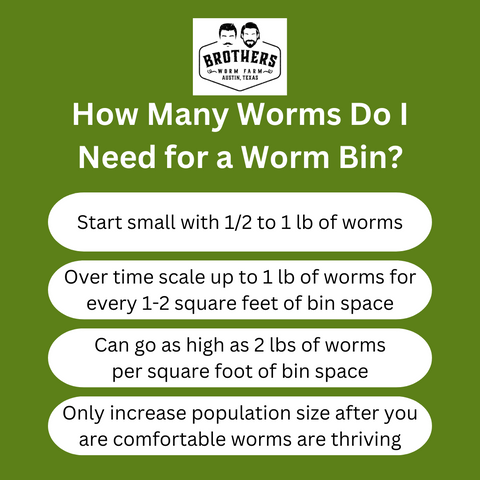
How to Start a Worm Farm at Home
Want to discover the benefits and fun of vermicomposting by starting your own worm farm at home?
This How to Start a Worm Farm guide offers simple, step-by-step instructions for creating your own worm farm, including how to make a worm farm from scratch or how to buy all of the worm farming accessories you need online.
Regardless of the approach you take, this guide will help you get a worm farm at home with an hour or less of work!
How to Start a Worm Farm at Home
Here are 5 easy steps to starting a worm farm at home:
- Container: Use a plastic bin with a lid. A 5 gallon bucket or small Rubbermaid bin (2’ x 2’ x 1’) works great. Drill 12 holes in the lid.
- Bedding: Add 3-4 inches of moist shredded cardboard, topsoil, peat moss, or finished compost.
- Worms: Add ½ lb red wigglers.
- Feed: Add 1/4 ounces of berries or a peeled banana.
- Location: Place a piece of cardboard on the bedding, close the lid, and keep the bin in a cool place.
If you want to get up and running quickly, we've compiled this list which can easily be purchased on Amazon:
* 1 5 Gallon bucket or a set of 3 buckets ($7.5 per bucket), or
* Plastic storage bin with lid ($27.50), and
* Red wiggler worms ($38)
The most important part of this process is bedding! It is not recommended to use store-bought potting soil or compost. Those products often have chemicals or fertilizers that can harm or even kill worms!

When in doubt, avoid a product and find another bedding source like the one pictured here with peat moss or this one with coco coir.
If you are unable to locate a good bedding source, just use moistened, shredded cardboard.
The worms will love it and cardboard is a safe carbon source for them to live in.
Once your bin is set-up, leave the worms in peace and check back in 24 hours!
At this point you want to see the worms eating the food you placed in the bin.
If not, make sure the bedding is moist like a wrung-out sponge and check back in another 24 hours as it can sometimes take worms a few days to settle in.
How Much Does It Cost to Start a Worm Farm
It can cost as little as $40 to start a worm farm, which includes the cost of the bin the worms will live in, bedding for the worm farm, and the cost of the worms:
It is also an option to purchase a manufactured worm farm and bedding, and you can spend anywhere from $100 to $400 depending on the type of worm bin you purchase.
The Maze Worm Farm is one of our favorite starter worm bins.
The advantages of a manufactured worm bin is that they save time and effort. Bins like the Maze Farm also have a better look and feel than most homemade bins.
How Long Does It Take to Start a Worm Farm
Starting a worm farm is a quick and easy process that can be accomplished in under an hour following these 3 steps:
- Purchase a container: 5 gallon bucket, plastic storage bin, or manufactured worm bin.
- Prepare bedding: place moist topsoil, finished compost, or shredded cardboard in the worm farm container.
- Buy red wiggler worms online, place them in the bin, and add cut up berries or fruit.
The 5 gallon bucket, plastic storage bin, or worm bin and the red wigglers can be purchased online in 5-10 minutes. Once those items arrive you can assemble the worm farm in 30 minutes or less.
The key is not to overcomplicate this process!
Almost all issues beginner worm farmers have are related to doing too much (e.g., too much food, too much water, etc) in the early stages.

These simple steps will greatly increase the probability of success in your early worm composting journey!
How Many Worms Do I Need to Start a Worm Farm
The number of worms you need for a worm farm depends on the square footage of the bin and how much waste you want to compost each week. 1 pound (~1,000) of red wigglers per square foot of worm bin space is a good benchmark, and some experienced worm composters have 2 pounds of worms per square foot. However, if you are new to worm composting, we recommend starting with 1/2 lb of worms per square foot, and then increasing the population over time as you gain experience.

We can’t stress enough how important it is to start with a smaller number of worms than you think you will need.
Once you have success for 4-6 weeks - with the worms being active and healthy-looking - you can then increase the worm population to 1 lb or so per square foot of bin space.
Red wigglers will eat their weight in food waste every 7 days or so, so plan to feed them 1/3 their weight every 2-3 days.
For example, if you have 1 lb of compost worms, feed them 5-6 ounces of food every 2-3 days and only feed once the last feeding is at least 80% finished!
How to Set-up a Worm Farm
To set-up a worm farm:

These steps sound easy because they are!
The challenge with starting a worm bin is finding the right container or worm bin and choosing the right bedding.
As mentioned above, use all-natural bedding like topsoil, peat moss, coco coir, or finished compost. Avoid store-bought soils, mixes, or compost!
Keep the bedding moist, the bin in a cool location where temps are below 80 degrees F or less, and feed only ¼ to ½ their weight every 3-4 days (or as needed as they finish the prior feeding).
Finally, be patient and avoid the tendency to tinker or add new and different foods to the bin. Worms are simple creatures and require simple care.
When in doubt, do less!
How to Start a Worm Farm for Fishing
The key to starting a worm farm for fishing is to begin with the type of worms you want to fish with. These are usually European, Canadian, or African nightcrawlers. To start the worm farm, buy a bin or container to keep the worms in, gather bedding like topsoil, compost, or shredded cardboard, and purchase worms. The final step is to moisten the bedding and place it in the worm farm, add the worms, and add a small amount of cut-up fruit for the worms to eat.

Once the worm farm is set-up and the worms are added, keep the bin in a cool, dry place. Moisten the bedding every few days and ensure the worms have readily available food that is easy for them to consume.
Worms don’t have teeth so they like softer foods that easily break down - cooked sweet potatoes, berries, peeled bananas, and avocados are all great starter options.
Remember that it can take worms 3-6 months to double their population size - this includes the time to breed, cocoons to hatch, and worms to grow to a size where you can use them for fishing.
So make sure to start with enough worms (1 lb or more) and lead time so that you have worms available when it is time to go fishing!
FAQs: How to Start a Worm Farm
How fast do red wiggler worms multiply?
Red wiggler worms can multiply quickly under optimal conditions. Typically, each adult worm can produce one cocoon per week, with each cocoon hatching 1-3 baby worms after approximately three weeks. Under ideal conditions of moisture, temperature, and food supply, the population of red wigglers can double roughly every 90 days. To maximize their multiplication, maintain your worm bin with adequate food scraps (avoiding meat and citrus), proper moisture, and a temperature range of 55-75°F.

For more on the reproduction habits of red wigglers, check out our How Do Red Wigglers Reproduce guide, which covers how worms mate and other details on their prolific breeding habits.
How hard is it to have a worm farm?
Having a worm farm at home is easy and requires less time than watering house plants each week. Worms need to be fed around 2 times per week, and their bin needs to be watered 1-2 times per week. For feedings, you can use fruit and vegetable scraps from your kitchen and watering is easily accomplished with a mister or spray bottle. The weekly time commitment for a worm farm is usually less than 5 minutes.
What are the disadvantages of a worm farm?
There are very few disadvantages of a worm farm, but a few common issues are:
One common but unfounded concern with worm farms is that worms will be crawling all over the house. In our experience, worms will rarely (as in almost never) leave their bin if they have moist bedding, moderate temperatures, and a good food source.
For the above issues, there are easy solutions that allow for success when starting a worm farm at home.
For example, flies or critters can be addressed by feeding small amounts of food with each feeding, which enables the worms to quickly eat the food before flies arrive.
To help beginner worm farmers, here's a simple step-by-step guide to getting started worm composting. Follow these steps, keep your worm farm inputs simple, and you’ll be a pro in no time!
Can you put eggs in a worm farm?
Dairy or meat products are not recommended for worm farms because they 1) will attract flies and 2) they are not healthy food choices for worms. However, egg shells are beneficial to worms and can be put in a worm farm - egg shells are a good source of calcium and can help balance out acidic pH conditions in a worm farm.
Can you put normal worms in a worm farm?
Yes - almost any species of worms, including normal worms in your area, can be put in a worm farm. To have success with worms in a worm farm, it’s important to keep the worm farm inside or in a shaded area, ensure the worms have a steady supply of soft fruit and vegetable waste, and to use a moist bedding like compost, topsoil, or shredded cardboard. With these factors taken care of, worms will happily thrive in the controlled environment of a worm farm.

What are the 5 mistakes that people commonly make when composting with worms?
Here are the top 5 mistakes people commonly make when composting with worms:
The key to success with composting with worms is to keep the operation simple and ensure worms have moist bedding and moderate ambient temperatures.
With these factors in place, your chances of early success will be high and most mistakes with worm farming can be avoided!
For more on troubleshooting common worm farm problems, see our guide to the 6 most common problems in worm farms.



